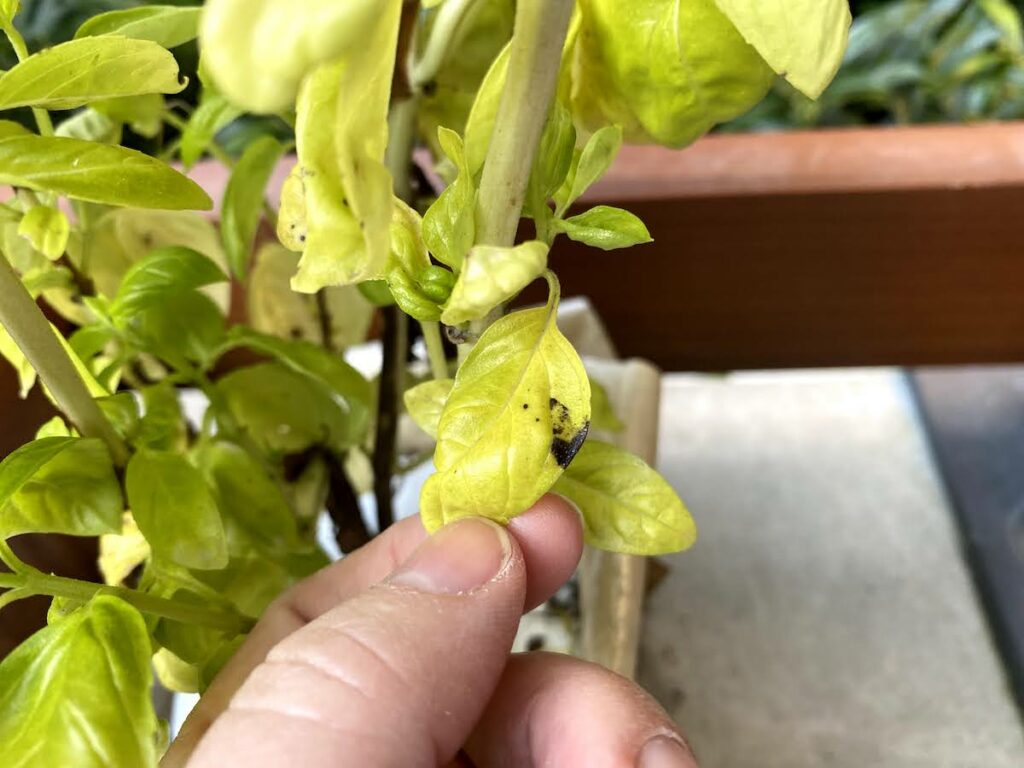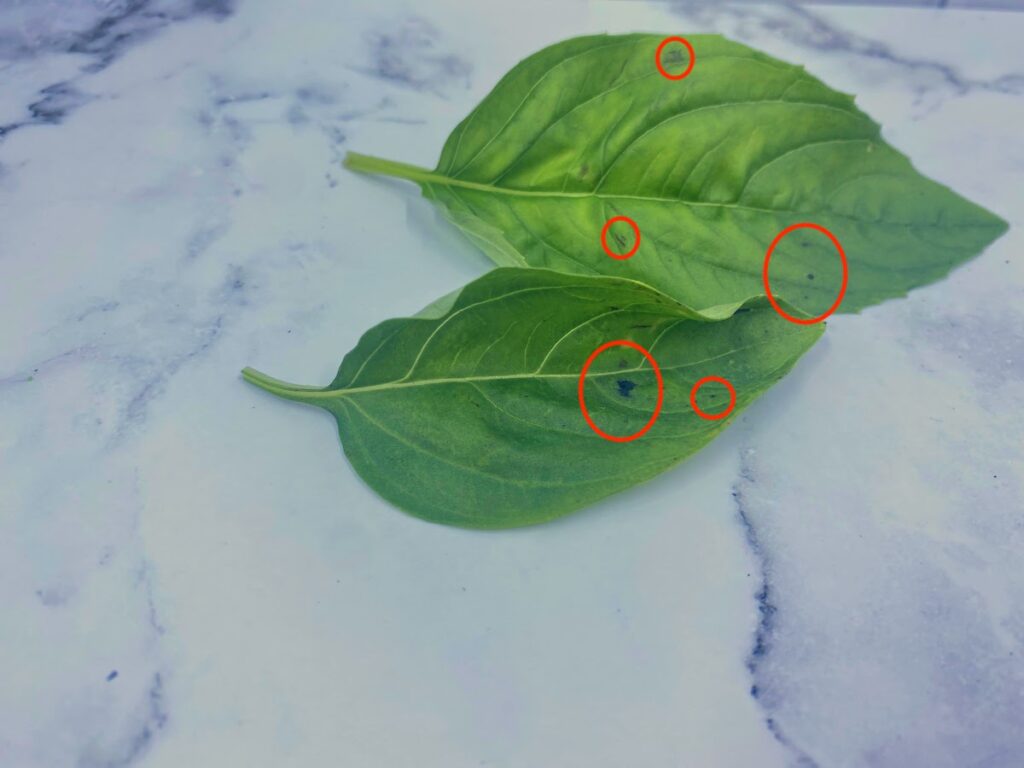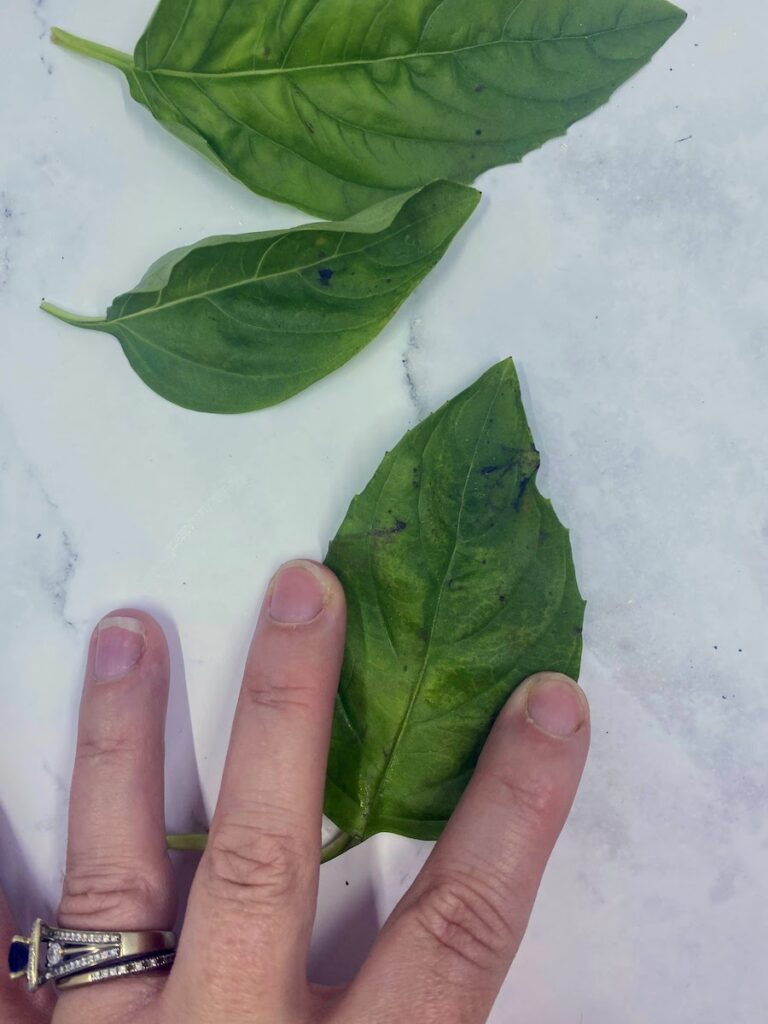As an Amazon Associate I earn from qualifying purchases. This website also participates in other affiliate programs and may earn commissions if you shop through the links used on this website.
(This article was originally published on October 8, 2021 and was last updated on September 15, 2022)
Black spots on your basil plant? If you’re wondering why are your basil leaves turning black, here are 4 common causes, and what you can do about it.
Basil is a summertime herb that is a favorite for many kitchen gardeners to grow. Its relatively simple and adds a tasty punch to your recipes.
But there are times when you want to cry for help, as your beautiful basil leaves develop black or brown spots. There are many reasons for these spots, including from exposure to cold weather, bacterial or fungal infections, annoying, hole-chewing pests, or even from a nutrient deficiency.

In this article we are going to share how you can diagnose what is causing your basil plant to develop black spots. We’ll also give you advice on how to treat it, and teach you how to prevent the problem from happening again in the future.
More Than 7,000 People Can’t Be Wrong!
For one-off problems with your basil or herb garden, a quick Google to solve the problem is great.
But if you want more help getting the herb garden of your dreams, mastering cooking with basil, or other creative uses of basil, Skillshare has some awesome herb-related courses (plus a ton of other interesting, useful and cool courses).
To date, more than 7,000 students have taken Indoor Gardening: Grow Houseplants, Veggies, and Herbs!
Normally Skillshare Gives A 7-Day Free Trial. You Get A 30-Day Free Trial (OR 30% Off An Annual Membership)
Our friends at Skillshare have graciously offered our readers an extended free trial, using this link here to sign up. Instead of 1 week to try out all their courses, you get a full month to try courses like:
- Indoor Gardening: Grow Houseplants, Veggies, and Herbs // (use this link to get a 30-day Free trial) // (use this link to 30% off an Annual Membership)
- Create a Small Space Edible Garden // (use this link to get a 30-day Free trial) // (use this link to 30% off an Annual Membership)
- 5 Easy to grow herbs, sowing, growing and harvesting // (use this link to get a 30-day Free trial) // (use this link to 30% off an Annual Membership)
- Crafting Infused Tea: Herb, Flower, and Fruit Iced Teas // (use this link to get a 30-day Free trial) // (use this link to 30% off an Annual Membership)
Sign up for a FREE 30-Day Trial (this link only)
Or Save 30% Off An Annual Skillshare Membership
If you know you’re going to love Skillshare, you can also sign up for an annual membership and save 30% with this link.
The Common Causes Of Black Spots On Basil Plants
Finding black spots on your basil plant is a nightmare for any gardener and herb enthusiast, and you may find yourself wondering ‘why are my basil leaves turning black?’.
Sadly, this isn’t as a simple answer as you might expect as it is a common symptom of multiple underlying issues.
You’ll have to pull on your detective boots and investigate to find out what’s causing those black spots on basil leaves. Here are the four most likely reasons why.
# 1 – Exposure To Extreme Cold
Basil is a herb (a member of the mint family actually!) which is native to hot, tropical, and subtropical climates. Although it can be grown as a perennial in most climates, those who have sudden drops in outdoor temperatures can find it more difficult to give these plants the TLC that they need. Simply put, basil will not tolerate any exposure to cold temperatures. They are also particularly susceptible to frost damage, and will die off when winter hits.
If you are growing basil outdoors in a temperate climate, you need to be wary of cool evening temperatures if it is placed outside too early in the season. If the overnight temperature drops, your basil will be shocked by the cold and the leave edges will begin to blacken and die.
This is especially true for younger plants you’re growing from seed, or recent transplants such as moving cuttings from inside to out.
# 2 – Bacterial And Fungal Infections
Certain fungal diseases can infect your basil plants. They are transmitted by insects or can also occur when water splashes the leaves of your plant, causing the affected leaves to get dark spots.
Colletotrichum, Septoria Fungi and Cercospora Leaf Spot are types of fungal disease that can infect your plant and result in black or brown spots on basil leaves.
Bacteria Pseudomonas Cichorii is a bacterial infection that causes moist patches and a few brown spots to develop on the leaves and stem.
One of the most common culprits for causing black spots on basil is a condition called downy mildew. Left unchecked, downy mildew can encourage one bacterial leaf spot on your plants. Even one leaf infected with this bacterial disease can quickly spread and kill all of your healthy plants. Not what any plant lover wants to see!
Downy mildew is appears as a greyish fungal leaf spot. It is often found on the underside of leaves, making it tricky to notice it at times. The dark spots on the fresh basil leaves then spread to cover a larger surface area.
If the bacterial leaf spots on basil leaves continue without treatment, the leaves may turn from yellow to brown or black before they die.
# 3 – Pest Infestation
As well as being tasty for us to eat, there are several pest species that like to munch on basil plants too.
“Leaf miner” is a cute name used to identify the large variety of nasty insects that feeds on basil leaves. These include bugs such as aphids, thrips, and spider mites.
When pests are the cause of damage to leaf tissue, there will be lots and lots (think hundreds!) of needle size black dots all over the leaf surface. Occasionally, these spots might look like dust as they are not a rich black but slightly more grey. These spots are residue, or the poop, produced by the leaf miners.
If it is leaf miner causing these spots and damage, you’ll know as you will also be able to spot some dry white and yellows area close to the black spots. These patches of yellow and white are where the leaf miners have eaten your leaf in some spots. When you find them in combination with the black poop spots, then you can be pretty sure that your basil is invaded by leaf miners. (and you probably might even see the bug themselves if you look more closely!)
Often pests that feed on most basil plants are prone to attacking plants that are already in a vulnerable state. They can also spread from other plants nearby of the same or different species that are already infected.
# 4 – Nutrient Deficiencies
Although it still can happen, a nutrient deficiency is the least likely cause of black spots on your basil leaves. Poor nutrition is more likely to result in leaves that curl or turn yellow.
At times, severe nitrogen deficiencies (or indeed over-application) can result in yellowing parts of the leaf dying and turning brown or black in color.
If you can safely rule out pests, infections, and cold damage, this could be the cause.
How to Identify the Cause Of Black Spots On Your Basil Plant

Now you know what causes black spots on basil leaves, you also need to know how to identify which of the causes has affected your plants.
# 1 – Cold Weather
As we’ve already mentioned, basil is not a fan of the cold! If you notice black spots on basil leaf edges check to see if the weather is the culprit… Check the forecast from the week leading up to the black spots appearing – especially the overnight low temperatures, where the cold can hit hardest.
If your basil plants developed black spots after a night when the temperature dropped to below 50℉ (10℃), then exposure to cold will very likely be the cause. Usually when temperature related, the whole leaf may turn black or the dark spot patches will be quite large.
# 2 – Diseases Leave Different Spots
Many fungal and bacterial diseases like to attack your basil plants, and trying to distinguish between different infections can be tricky, but knowing what you are dealing with helps you to treat your plant correctly. With careful examination, you will notice that the different diseases tend to have slightly different colorations, textures, or rings around them.
Pseudomonas Cichorii, a bacterial disease, will create wet, dark spots on the leaves of your basil plant. These yucky blotches will eventually spread through the plant and begin to rot the stem.
The fungal disease Colletotrichum will manifest as black spots on the leaves that eat through the leaf and fall out, leaving holes in the leaf.
Cercospora Leaf Spot looks a bit different and can be identified by larger black spots that have a yellowish ring around them. With time, they will develop a white color in the middle of the spot. They can also fall out once that part of the leaf has completely died and dried out.
Spots caused by the Septoria fungi will visible as more of a greyish brown color instead of black and be surrounded with a dark brown ring.
# 3 – Check The Underside Of The Leaves
If it is the undersides of the leaves are what is affected then it is likely to be Downy Mildew that is the cause of your basil plant illness. Check the undersides of the leaves and look closely for a black or brown mould-like substance.
In the early days it is the undersides of the leaves which are most affected by Downy Mildew, but given time it will spread to the tops of lower leaves as well.
If you manage to spot it before it moves to the tops of the leaves you are more likely to be able to remedy the problem.
# 4 – Problems Caused By Leaf Miners
Leaf miner pests, like aphids, thrips, and spider mites, can sometimes be visible themselves on your basil plants. But more often than not, it is the evidence they leave behind that is the tell-tale clue that their presence has attacked you sweet basil plants.
Yup – the black spots that these bugs leave behind are sometimes where the plant tissue has been eaten away, but more likely, these pinpoint black specks is actually the insects poop! (gross – right!)
To identify these miniature critters you’ll need to work your eyesight, as they are pretty tiny.
Thrips are very small and pale in color, making them super hard to spy in between the leafy masses of basil. A clue it may be these critters though is that they lay their eggs in the leaf tissue so you can sometimes see little bumps on the leaf surface.
Spider mites are incredibly small (about a millimeter long) but you’ll know if it is these guys as they leave their tell-tale fine webbing spun between the basil leaves and around the base of the stem.
Aphids are a bit bigger, so you may actually be able to spot them if you look closely at the leaves. Another way to know if aphids are the culprit is to check the leaves for a sticky clear fluid that looks a bit like honey.
How To Treat The Different Causes Of Black And Spotted Leaves

By now your detective work should have hopefully helped you to identify the cause of your black spots (or at the very least narrowed it down your list of suspects!)
In the next section we’ll explain how to treat your basil plant so that it can become green, leafy and healthy again, ready to continue producing delicious sweet basil for the rest of the growing season.
# 1 – Cold Exposure
Sadly, if it was the cold that led to your basil plant turning black, there isn’t a lot that can be done to ‘cure’ your plant. The only thing you are able to do is remove all of the affected leaves by pruning them away.
When basil has been exposed to cold and frost, the black spots which appear are signs of necrosis, which are irreversible and will continue spread onto the remaining healthy leaves if left on the plant.
Prune away dead or dying leaves, snipping gently close to the stem. Regularly harvesting or trimming your plants is essential to their good health and growth.
To prevent future cold attacks, you can cover the basil plant with bell jars and tents. Hoop tents are a popular way to cover and preserve basil from short-term cooler weather. Also keep the planting soil moist all the time. Wet soil will stay warmer and retain more heat than dry soil.
For an unexpected cold snap, consider moving your outdoor plants indoors, or at least to a more protected area, such as a porch or close to a building until the weather picks up again. Of course, you could also simply grow your basil indoors, year round, to avoid temperature fluctuations, but then you’ll need to consider sunlight, as basil needs a lot of it.
When the colder weather is well and truly coming, consider trimming the plants down. You can harvest as many of the fresh leaves as possible and preserve the leaves for cooking and other recipes by drying or freezing them.
# 2 – Fungal And Bacterial Infections
As long as they aren’t too far gone, a lot of bacterial and fungal infections in basil can be treated with an organic bicarbonate-based fungicide.
Trim away any affected leaves off before application the solution. It’s easy to make this protective spray at home using a few drops of natural dish soap, a half teaspoon of baking soda, and one liter of water. This can also be effective on powdery downy mildew if you can spot it early.
If the fungal or bacterial infection is severe, you will need to remove the entire infected plant or else you run the risk of the infection spreading to other nearby crops.
When disposing of affected diseased plants, they should be carefully burnt or thrown away. These specimens should not put on the compost pile as the fungal and bacteria spores continue to grow and eat the decaying plant. Which then could spread around your entire garden.
# 3 – Pests
Basil plants which have become home to families of leaf miners can be treated with neem oil. This is an organic pesticide that is naturally derived from the neem tree, and available online or through most garden centers. This is preferred to synthetic pesticides which can be harmful to other (good!) insects and leave lasting chemicals and damage in your soil.
You can also make the same dish soap and baking soda combination spray which was mentioned for fungal infections to treat and banish spider mites.
If there are leaves that have been heavily damaged, prune them away to give the plant a fresh start. Any potted basil plants should also be repotted with fresh soil and an organic fertilizer mixture to prevent any eggs which the pests may have laid from surviving underground in the old soil.
# 4 -Nutrient Deficiencies
Although the most unlikely cause, if you believe your basil is developing dark spotting from a nutrient deficiency, the best way to support your plant back to health is by adjusting your fertilizing schedule, and possibly also your watering schedule, as over watering can wash away nutrients and cause your basil to turn yellow.
If your basil plant has been lacking in some TLC and has been a while since it was fertilized, give it a layer of compost or an organic fertilizer that is high in nitrogen to see if this was the cause.
Alternatively, if you have been over fertilizing your basil, give it a break for a month, without the extra nutrients and see if it makes a recovery.
As with the other problems, prune away affected spotted leaves to support the regrowth of the healthy plant.
How To Prevent Your Basil Plant From Developing Black Spots
As with all outdoor and indoor gardening, when it comes to dealing with infected leaves, prevention is better than cure. It is much more difficult to get rid of diseases or pests than to keep them away from your healthy plants in the first place.
To keep your basil plants healthy and resilient to the threats of pests and infections, the most important thing to do is ensure your basil is kept in optimal growing conditions.
Basil plants love heat, sunlight, good air circulation, nutrition, and semi-dry conditions are key for basil to thrive. Make sure your plants look healthy, and act quickly if they show signs of stress such as any discolouration or wilting.
Here are some other key tips for healthy basil:
Space your Plants
When you have many plants, try to give them some space to grow, roughly at least one foot apart if you can, to ensure adequate air circulation. Although they enjoy warmth, they need to be kept out of a humid environment. Basil can be grown in greenhouse, where it appreciates the extra heat, but watch these extra carefully as it can make them more susceptible to fungal infections due to the high humidity inside them.
When plants that are planted too close together it will make it more difficult for the lower leaves to dry out, even if they are kept outdoors. The damp and humid conditions are where bacterial and fungal diseases can thrive and take over!
This includes basil planted in containers – they need to be large enough for the plants to have space!
Water at the Base
When you water your basil plants it’s best to do so directly at the base of the plant, avoiding the leaves on the plant. Wet leaves are one of the main ways for your plants to get bacterial leaf spot…and when you think about it, it makes sense: fungus and bacteria love moisture!
Basil isn’t a fan of wet soil but they should be watered a few times a week in the heat of the summer growing season.
The morning is the best time to watering them too. This allows for any leaf droplets to dry out before the cooler evening temperatures set in.
Soil Conditions
Transplant your basil plants into soil that contains a healthy balance of nitrogen, potassium and phosphorus, and has excellent drainage to avoid the soil from being too wet.
A good way to control the soil condition is to grow your basil plant in a pot or container with a good drainage hole setup. This also has the dual benefit as you are able to bring it indoors more easily if cold temperatures are predicted.
Transplanting Early
If you plan to grow your basil outdoors, be extra careful not to transplant your seedlings too early in the spring. At this time of year the temperatures can fluctuate greatly and it can still get pretty cold, especially on your new little sprouts! Be sure to harden off your seedlings for a few weeks before replanting outside.
Check Them Regularly!
If you can, give your plant a thorough check over a couple times a week to look for any signs of pests. This way you can act fast and treat them with neem oil before any serious damage is done. You’ll need to keep checking on your plants anyway to pinch off any flowers that are developing, unless you plan to collect and save the seeds for next year. This is also a good time to check for signs of distress.
Pests will often target weaker or more sickly plants, so if you follow all of these measures to keep them healthy it is unlikely that you will get an infestation.
Other Frequently Asked Questions
Can You Eat Basil With Black Spots?
If the leave on your basil plant are showing black spots, they are still safe to eat. However, the flavor of the leaf may be a bit different. Damaged basil leaves can taste bitter, and if very spotted or bad, may even be a little slimy. It could spoil your food if you use them, so stick with fresh green leaves where you can!
Will The Leaf Spot Go Away On Their Own?
They Won’t!
If a bacteria or fungus is causing the leaf spots then it won’t go away on its own. In fact, it is contagious to the other basil leaves and plants you may have close by. You need to remove the infected leaves as soon as you notice them and clean any gardening tools that you used with soapy water.
Going forward you can treat the plant with sulfur or copper-based fungicides by applying them weekly or bi-weekly, depending on the severity of the condition.
